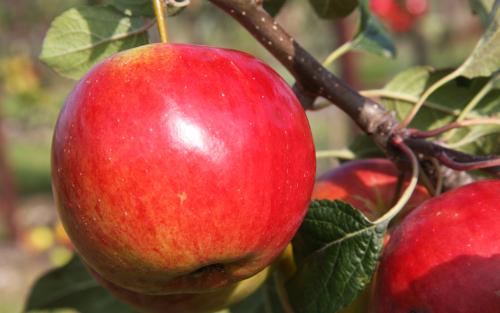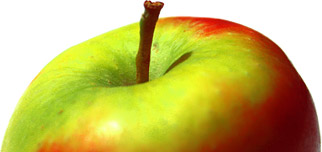
One of a number of new varieties developed by the Laxton Brothers Nursery in the UK in the early 1900s and grown commercially on a small scale. It remains a popular garden variety in the UK, but is a noted biennial bearer. It is a useful substitute for Cox's Orange Pippin (one of its parents), having some of the aromatic flavour of that variety but much easier to grow.
Whilst most apple varieties are not self-fertile (they cannot pollinate themselves and need a nearby apple tree of a different variety to set fruit) it is interesting that there is a streak of self-fertility running through Cox's Orange Pippin and its offspring, and Laxton's Fortune is partially self-fertile. This means it will probably set light crops even if there is no pollination partner nearby - but cropping will be better with another variety to cross-pollinate the blossom.
Fortune is often referred to as Laxton's Fortune - do not confuse with the 1995 variety also called Fortune, released by Cornell University in the USA, a cross of Empire and Schoharie Spy.
Laxton's Fortune apple identification images
All images copyright Orange Pippin unless otherwise stated.
USDA identification images for Laxton's Fortune
The identification paintings in the USDA Pomological Watercolor Collection span the years 1886 to 1942.
Citation: U.S. Department of Agriculture Pomological Watercolor Collection. Rare and Special Collections, National Agricultural Library, Beltsville, MD 20705.
Visitor reviews
- 28 Aug 2021 MARYLAND, United StatesHave grown LF for about 10 years now (on a Geneva 30, semi-dwarf rootstock) and the tree has cropped the last 5 or so. A bit whippy, definitely little resistance to Fireblight, Scab or Cedar-Apple rust, but it survives anyway. Apples are modest sized, sweet, slightly aromatic, nicely flavored but with a bit of a chewy texture as grown in Maryland (much hotter than Britain).
- 16 Sep 2017 HARROGATE, United KingdomWe have a Laxton's Fortune in our garden in Harrogate. It has fruited really well this year. We had it identified last year by RHS Harlow Carr who were offering a free apple identification day. Delicious juicy red apples with red flashes inside.
- 31 Aug 2017 CUMBRIA, United KingdomI planted two as cordons three years ago. One has succumbed to canker this year, the other has collapsed under its fruit load. I removed all but four apples and we have been eating them for three weeks now, they seem to be happy in a cool kitchen. The stock is M106 and I intend to replant in out orchard this winter and grow as a tree. Best flavour we have after a shy Ashmead's Kernel
- 13 Oct 2012 LONDON, United KingdomI've got a 3 year old Laxton's Fortune tree. I love the apples. True they don't keep, but they are so sweet, aromatic and juicy. Mine look spectacular too, deep scarlet.
- 29 Feb 2012 United StatesI am getting ready to graft this variety on a tree that I am changing it's varieties.
- 23 Sep 2010 OXFORD, United KingdomThe earlier comments say it all: Fortune is the best tasting of all dessert varieties, and it is commercially a non-starter because it bruises so easily. But if you have a tree, or know of an orchard, then now (late Sep) is the time to get busy. Boxford Farms (Suffolk) used to grow them in substantial quantities, but I expect they may have been grubbed in favour of something saleable.
- 26 Oct 2009 OUTSIDE WOBURN, BEDFORDSHIRE, United KingdomMy neighbour has an apple that could be a Laxton Fortune but I have never eaten that particular apple to be able to comment. The tree was mature when I moved in 23 years ago so it is obviously an old variety. This apple is red with yellowish / green streaks travelling from top to bottom. The flesh is soft and an almost yellow colour; the flavour is just devine - it has be likened to strawberries but I cannot see the connection. The flesh is not red but it has red "flashes". When I first ate one I thought my gums were bleeding. I would dearly love to purchase one of these trees so if anyone knows of a grower in the UK that sells them I would appreciate it. Failing the purchase of a tree I will try to graft a cutting onto existing apple stock but this is not my ideal solution. S E Pearston
- 23 Sep 2009 WEST MELTON CANTERBURY, New ZealandThere is a number of small heritage fruit tree nurseries near Christchurch in NZ. We got a Laxtons Fortune apple along with russets and other heritage fruits. Plus Oh Joy - a Damson that I haven't seen since I left Dorset in 1984. The orchard is only 3 years old so I can't wait for the little trees to grow big enough to start producing.
- 22 Sep 2009 NORFOLK, United KingdomWe inherited a Laxton's Fortune with a house we bought in Bedfordshire in 1978. It was still going strong when we moved away in 2005. The apples were identified for us by a wholesale greengrocer relation as 'Laxton's Fortune by a Bedfordshire grower'. It can sometimes be found on sale as an organic fruit. Lovely crispy, juicy apple, it tended to bruise as it was being eaten - even straight from the tree - and it was always a race to harvest the ripe fruit before the starlings found them! We're now in the process of sourcing a dwarf variety for our Norfolk garden.
- 17 Aug 2009 SOMERSET, United KingdomI remember eating a Laxton Fortune in 1975, grown by Pank of Sussex, I believe. Best apple I've ever tasted. Does anyone know if the orchard still exists?
- 23 Jul 2009 POOLE DORSET UK, United KingdomI used to work with Fortunes and they are my favourites next to Beauty of Bath, but can never find either of them in the shops. Do you know where I can get any in the Poole district?
Tree register
United States
- Aaron Millis in HELENA, MT
- Dave Beamer in Santa Barbara, CALIFORNIA
- Nathan Parker in Mount Shasta, CA
- Peter in Croom, MD
United Kingdom
- Adam Norman in Tadcaster, ENGLAND
- Allison Kirby in Plymouth, DEVON
- Bob Hickman in Halesowen, WEST MIDLANDS
- Celia Cropper in Manchester, LANCASHIRE
- Clare Burrows in Bodorgan, ANGLESEY
- David in Hereford,
- Dougas Wilson in Perth,
- Hamish Ross in Ely, CAMBRIDGESHIRE
- Helen Parker in Southampton, HANTS
- Jean Lippett in Martock, SOMERSET
- John Meager in Reading, BERKSHIRE
- Mariska Van Loenen in Aberdeen, ABERDEENSHIRE
- Martin Timms in Baldock, HERTFORDSHIRE
- Melanie Fuller in Harrogate, NORTH YORKSHIRE
- Mr m Buckler in MATLOCK, DERBYSHIRE
- Paul Freeborough in West Bridgford, NOTTINGHAM
- Paul Smith in Chatteris, CAMBRIDGESHIRE
- Pete High in Cumbria
- Phil Hands in EXETER,
- Phillip Orion in Eastington, GLOUCESTERSHIRE
- Richard Seed in Southampton, HAMPSHIRE
- Robert Edmonds in Muswell Hill, LONDON
- Steve Halliwell in Poole, DORSET
- Steve Webster in Truro, CORNWALL
- Tim Hucker in London,
- Zed Zapasnik in Harrow, MIDDLESEX
Australia
- Stephen Boardman in Acton Park, TAS
New Zealand
- Giles in HAMILTON, WAIKATO
Spring blossom records for this variety
2020 season
- 7th April 2020 - tree owned by Zed in Harrow, United Kingdom
- 7th April 2020 - tree owned by Zed in Harrow, United Kingdom
2013 season
- 17th May 2013 - tree owned by Celia in Manchester, United Kingdom
2012 season
- 8th April 2012 - tree owned by Zed in Harrow, United Kingdom
2011 season
- 15th April 2011 - tree owned by Robert in Muswell Hill, United Kingdom
- 5th April 2011 - tree owned by Zed in Harrow, United Kingdom
2010 season
- 8th May 2010 - tree owned by John in Reading, United Kingdom
2009 season
- 18th April 2009 - tree owned by Robert in Muswell Hill, United Kingdom
Record your blossom dates in our Fruit Tree Register - more >>.
Harvest records for this variety
2020 season
- 4th week August 2020 - tree owned by Zed in Harrow, United Kingdom
- 4th week August 2020 - tree owned by Zed in Harrow, United Kingdom
2017 season
- 2nd week September 2017 - tree owned by Melanie in Harrogate, United Kingdom
2016 season
- 4th week September 2016 - tree owned by Mariska in Aberdeen, United Kingdom
- 2nd week September 2016 - tree owned by Richard in Southampton, United Kingdom
2013 season
- August 2013 - tree owned by Dave in Santa Barbara, United States
2011 season
- 1st week September 2011 - tree owned by Helen in Southampton, United Kingdom
- 1st week August 2011 - tree owned by Zed in Harrow, United Kingdom
2010 season
- 2nd week September 2010 - tree owned by Steve in Poole, United Kingdom
- 1st week September 2010 - tree owned by Zed in Harrow, United Kingdom
2009 season
Origins
- Species: Malus domestica - Apple
- Parentage: Cox's Orange Pippin x Wealthy
- Originates from: Bedford, England, United Kingdom
- Introduced: 1904
- Developed by: Laxton Brothers Nursery
- UK National Fruit Collection accession: 1974-343
Identification
- Awards: RHS AGM (current)
- Country of origin: United Kingdom
- Period of origin: 1900 - 1949
- Fruit colour: Green / Red
- Flower colour: White
- Leaf colour: Green
- Annual cycle: Deciduous
Using
- Picking season: Mid
- Keeping (of fruit): 2-3 weeks
- Flavour quality: Very good
- Flavour style (apples): Aromatic
- Cropping: Good
- Food uses: Eating fresh
- Wildlife: RHS Plants for Pollinators
Growing
- Gardening skill: Experienced
- Flowering group: 3
- Pollinating others: Average
- Ploidy: Diploid
- Vigour: Slightly small
- Bearing regularity: Biennial tendency
- Fruit bearing: Partial tip-bearer
- Self-fertility: Partially self-fertile
Climate
- Climate suitability: Temperate climates
- Climate suitability: Mild damp climates
- Summer average maximum temperatures: Cool ( 20-24C / 68-75F)
- Summer average maximum temperatures: Warm (25-30C / 76-85F)
- Cold hardiness (RHS): H6 (to -20C)
- Summer average maximum temperatures: Cold (< 20C / 67F)
Other qualities
- Disease resistance: Average
- Scab (Apple and Pear): Some resistance
- Canker: Some susceptibility
Where to buy trees
The following tree nurseries offer Laxton's Fortune apple trees for sale:
- Orange Pippin Fruit Trees (UK) United Kingdom
Laxton's Fortune apple trees
Where to buy fresh fruit
The following orchards grow Laxton's Fortune:
United Kingdom
England - midlands
- Meynell Langley Trials Gardens, Derby
- Walsgrove Farm, Worcester
England - north
- Lockwood Hey Orchard, Saddleworth
England - south-east
- Lavenham Brook Vineyard and Orchard, Sudbury
- Home Cottage Farm, Iver
- Crapes Fruit Farm, Colchester
- Kimpton Manor Apple Press, Andover
- Holton Orchards, Halesworth
England - south-west
- Charlton Orchards, Taunton
Canada
British Columbia
- Apple Lane Orchards, Denman Island
- Salt Spring Apple Company, Salt Spring Island
References
- Apples of England (1948)
Author: Taylor - Fruit Expert
Author: Hessayon

